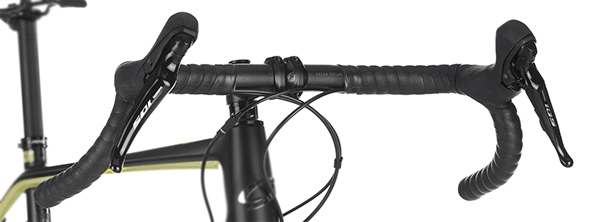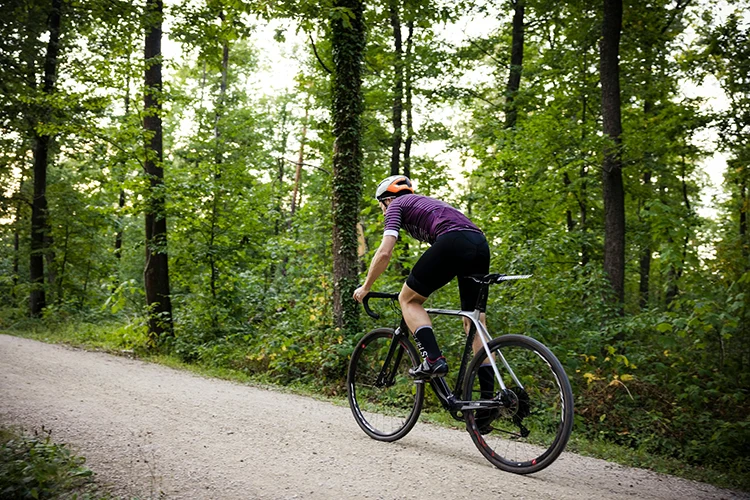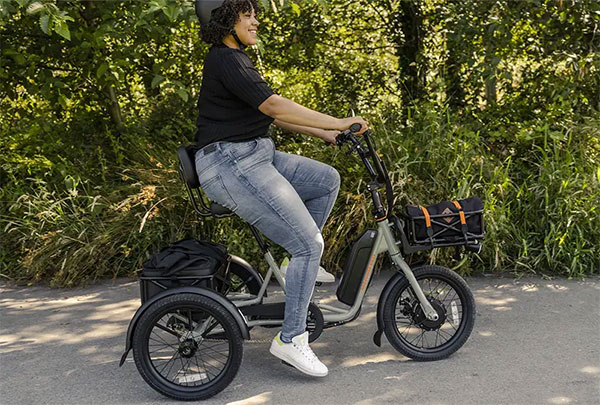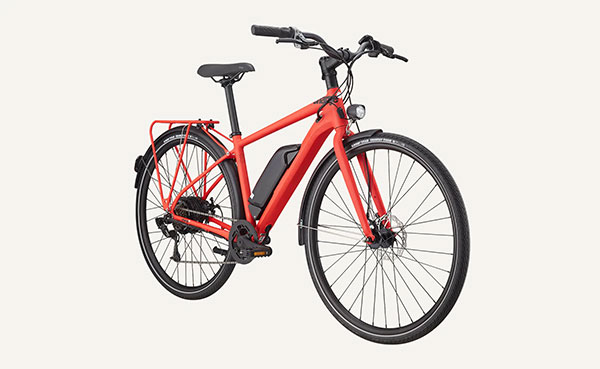The cyclocross vs gravel bike discussion has been going on for quite a while. They seem to have so much in common, so do you really need both? We get these questions a lot, so here are our two cents. Learn about the similarities and differences between the two types.
Gravel and cyclocross bicycles are both built to go off-road. Both look a lot like a road bike. Both also have drop bars, wide tires, and similar frames. So where’s the catch?
While gravel and cyclocross bikes look the same to a layman focusing on the big picture, you get to discover some important differences once you take a closer look.
In this article, we’ll get into the nitty-gritty details and tell you all about their unique features. But first, let’s quickly learn what cyclocross and gravel bikes are.
What Is a Cyclocross Bike?
A cyclocross bike is a unique type of drop-bar bicycle that is built to be used in cyclocross racing. Cyclocross races usually last up to an hour and take place on a short off-road course with features like mud, barriers, sandpits, rocks, steps, and hills that are too steep to ride.
Therefore, cyclocross bikes are aggressive two-wheelers built to be ridden hard for a relatively short period of time. They also need to be carried over obstacles and be fast and easy to handle on very challenging terrain.
What Is a Gravel Bike?
A gravel bike is another type of drop-bar bicycle that is made for long, sustained efforts on gravel and dirt roads. It is also called an adventure bike because it is commonly used for adventures and multi-day trips, be it bikepacking or bike touring.
Longer read: 8 Reasons Why Gravel Is The Hottest Trend In the Cycling World
As a result, gravel bikes are put more emphasis on comfort rather than performance. This is reflected in the materials used, the frame design, tires, gears, and other features.
Related: Best Gravel Bikes
Contents
Cyclocross vs Gravel Bikes — The Main Differences
Cyclocross vs Gravel Tires
When looking at gravel bike vs cyclocross bike side by side, they both have tires that are intended for off-road riding. However, that’s where the similarities end. Cyclocross vs gravel tires differ in two main ways:
- Size
- Compound
Cyclocross tires are limited under UCI rules to a maximum of 33mm in width. Therefore, cyclocross bicycles are usually made with no extra clearance for wider tires than that. Moreover, tires for cyclocross are always 700c in diameter, because speed and rolling efficiency are more important than comfort.

On the other hand, gravel bikes go much wider than that. Many gravel models nowadays have tires that are at least 38mm wide, plus they can accommodate both 700c and 650b diameters. Models with 700c wheels often go up to 47mm in width, whereas those with 650b wheels can get 2.25” wide, which is MTB territory.
When it comes to the type of rubber used, cyclocross tires are usually made from softer compounds. This is because soft rubber provides more grip on grass and mud, which are often part of cyclocross courses. Moreover, the knobs are usually quite prominent for the tire to have better traction on slippery ground.
Gravel tires are made from harder compounds because they are usually ridden on hardpacked gravel and dirt roads with small and large rocks. This makes them more durable and more efficient as well. Their tread profile is also less aggressive and slicker, which is ideal for dry and dusty summer riding.
See the Gravel & CX Bikes on JensonUSA
Cyclocross vs Gravel Bikes – the Frame
At first glance, frame geometry looks pretty much the same when we look at the cyclocross vs gravel bike discussion. However, big differences disclose themselves upon closer inspection.
As cyclocross bikes are made for short and aggressive efforts, they’re built around a frame that’s optimized for performance. It has a shorter wheelbase, higher bottom bracket, steeper head tube angle, and more saddle-to-handlebar drop.

The top tube is often almost horizontal which makes the front triangle bigger and allows riders to easily carry the bike over obstacles and up steep slopes. The chainstays are usually up to 425mm long which ensures snappier handling and better uphill traction.
Conversely, when we reach gravel bikes in the gravel bike vs cyclocross discussion, gravel bikes have a more relaxed and versatile geometry that makes them suitable for short and explosive races, day-long rides, and even multi-day adventures.
The wheelbase is longer, the BB is lower, and the head tube angle is slacker to provide more stability. The rear triangle and the fork have more clearance for bigger tires and both 700c and 650b wheels.
Riding Position
The riding position differs greatly between the cyclocross vs gravel bike options. The former puts emphasis on performance whereas the latter emphasizes comfort.
Cyclocross bikes put the rider in a lower and more aerodynamic position that’s optimized for racing. Comfort is secondary because riders usually spend up to an hour racing a cyclocross course.
On the other hand, gravel bikes come with a smaller saddle-to-handlebar drop which puts the rider in a more upright position. This relaxes the body, provides a better overview of the road ahead, and allows the rider to spend hours or even days in the saddle.
Gears
In terms of gearing, as well as in all other aspects, looking at the cyclocross vs gravel bike comparison, they are optimized for their intended uses.
Therefore, cyclocross bikes usually have narrower gear ranges that save weight and eliminate unnecessary gears. In cyclocross racing, you don’t need very high gears because you can’t go very fast, and you also don’t need very low gears because it’s easier to carry your bike over a steep and slippery slope than ride it.

Common gearing combinations on cyclocross bikes include a subcompact 46/36T chainset and an 11-28T cassette. However, more and more manufacturers are also opting for 1×11 and 1×12 drivetrains nowadays.
Gravel bikes have wider gear ranges because their intended use is more versatile. You need high gears to zoom on smooth tarmac and granny gears to tackle a grueling gravel climb.
Related: Bike Ride is Crucial For Everyone
The most common combinations pair compact 50/34T cranksets with wide-range cassettes, such as 11-32T or 11-34T. However, some manufacturers widen the range with subcompact cranksets and even 11-36T cassettes. Many also opt for 1×11 or 1×12 drivetrains.
Brakes
Disc brakes have become the standard for almost all types of bicycles nowadays. Cyclocross and gravel bikes are no exception.
Up until a few years ago, cyclocross bicycles used to be equipped with cantilever brakes that offered some weight saving at the expense of braking performance. But most cyclocross bikes feature mechanical or hydraulic disc brakes today, depending on the price tag.

Gravel bikes also come with disc brakes, with almost zero exceptions. Simply speaking, disc brakes offer a lot more braking power and better braking performance, at a weight penalty that’s negligible for most riders.
So all in all, looking at the cyclocross vs gravel bike comparison, they are not that different anymore, at least when it comes to brakes.
Riding
Apart from bringing about the development of a new riding discipline, gravel bikes have also incited a formation of a unique subculture within the cycling world.
Gravel riding is usually viewed as more relaxed and more inclusive than road and cyclocross riding. Gravel bikes are often ridden in a t-shirt, with a handlebar or a frame bag to carry the essentials.
The emphasis is on comfort, distance, exploration, and adventure. Of course, this is a simplification as every rider is different, but it’s a close approximation.
This is where the cyclocross vs gravel bike difference really shines through. Cyclocross riders are usually focused on average speeds, lap times, aerodynamics, and weight savings. The riding is more technical, the terrain is more gruesome, and riders only have one hour to show what they can do, so they GO HARD.
Again, every rider is different, so it’s perfectly fine if you take a different approach to cyclocross than this one.
Mounts
Gravel bike frames come with numerous eyelets on the fork and the frame for fitting mudguards, racks, bottle cages, and bags. They are often used for bikepacking and bike touring trips, so they need to have plenty of room for panniers, extra water bottles, and frame bags.

Pure cyclocross bikes usually have no mounts because they don’t need any. The only exception is bottle cage mounts, but they are still a contended matter in the cyclocross world.
However, some manufacturers have started adding frame and fork mounts because they’ve realized cyclocross bicycles are a popular choice for year-round commuters who need mudguards and possibly a rear rack for daily urban and off-road commutes.
Related: Gravel Bikes vs Road Bikes
FAQ
Are cyclocross and gravel bikes the same?
No, cyclocross and gravel bicycles are not the same, even though they appear to be similar. Cyclocross bicycles are built for short efforts around cyclocross courses, so they feature aggressive geometry and performance-oriented features. Gravel bikes are built for longer efforts and multi-day trips so they emphasize comfort and features that allow more versatile use.
Should I buy a gravel bike or cyclocross?
It depends on what type of riding you plan to do. If you want to race cyclocross then get a cyclocross bike.
If you want to do a little bit of everything (road, cyclocross, gravel, bikepacking, touring), then a gravel bike is a better choice.
In a situation where can only get one bike but want to practice both disciplines, gravel is a better choice because you can fit narrower tires, but you can fit wider tires than 33mm on a cyclocross bike.
Are cyclocross bikes good for road riding?
Yes, cyclocross bikes are a good choice for road riding. Their geometry is very similar to that of pure road bikes. To make them more suitable for fast rides on smooth pavement, consider fitting road-specific tires and a compact or a semi-compact crankset.
Why are cyclocross bikes so expensive?
Cyclocross bikes are expensive because they are built to be abused on demanding cyclocross courses. Therefore, they are made with quality materials and durable components to be able to withstand the hard conditions in cyclocross racing.
Why do gravel bikes have flared bars?
Gravel bikes have flared bars to improve handling on technical gravel and dirt roads, especially on descents. Flared bars also provide more room for handlebar bags, which are a common part of a gravel cycling kit.
What is the difference between cyclocross and road bikes?
Cyclocross and road bikes have similar frame geometry but that’s where the similarities end. Cyclocross bicycles have wider tires, disc brakes, and a higher bottom bracket. They are optimized for better speed and handling on off-road conditions, whereas road bikes are optimized for speed, aerodynamics, and lightweight features.
Are gravel bikes a fad?
No, gravel bikes are not a fad, even though some riders are still not convinced. They have been around for about a decade, which proves riders have a real use for them that other types of bicycles do not provide. Moreover, an entire cycling subculture and riding discipline has formed around gravel bikes, which shows that they are here to stay.
Do cyclocross riders clip in?
Yes, cyclocross riders clip in. They use clipless shoes and pedals because the muddy conditions would make it too slippery and almost impossible to pedal with flat pedals. They usually use SPD pedals.
Why are gravel bikes so popular?
Gravel bikes have gained a lot of popularity because they steer riders away from busy streets and onto low-traffic gravel and dirt roads. This way, riders can enjoy cycling without worrying about cars and trucks, enjoying the scenery and experience more. Gravel bikes are also very popular because they are a do-it-all solution as they perform reasonably well in most conditions.
Can I use a gravel bike for cyclocross?
Yes, you can use a gravel bike for cyclocross. It won’t be ideal but you won’t have to make too many compromises and sacrifices. All you need to do is fit narrower tires (up to 33mm) and swap a flared handlebar (if you have one) for a regular one.
The only problems you might have will be caused by the low bottom bracket and the front triangle that might make it hard to shoulder the bike around the course.
See the selection of gravel and CX bikes on evo – REI – Jenson USA




